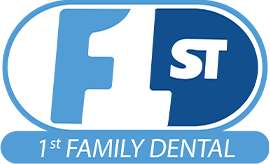Regular visits to the dentist should be a positive experience for children and parents. In order to help you ensure your child has the best possible experience, even if dental treatment is needed, we offer the following suggestions and recommendations:
Making the First Pediatric Dental Visit a Positive Experience
- Start dental visits early on in life. At 1st Family Dental, we recommend bringing your child for their first dental visit near your child’s first birthday, and no later than 18 months. The sooner you begin dental visits, the better the chance you can help prevent dental problems and also acclimate your child to dental visits.
- If you have a toddler who has not yet seen a dentist, we recommend bringing your child to one of our convenient locations. This allows them to get used to the sights and sounds of a dental office, meet the doctor and the staff who will be working with your child, and help them to feel empowered and confident.
- Select an appointment time when your child is alert and rested. We suggest that the last meal be about 2 hours before the visit, but it is also important to ensure your child is feeling their best, so keeping up with your child’s regular meal or snack schedule is also important.
- Parents have the greatest influential role in a child’s dental health. Children often perceive a parent’s anxiety which makes them more fearful. They tolerate procedures best when their parents understand what to expect and prepare them for the experience. If you have any questions about the appointment, please ask. As you become more confident, so will your child.
- Prepare your child for his or her visit by talking about visiting the dentist. Make sure your child knows that his or her dentist is a friend and will help your child keep his teeth healthy. Encourage your child to ask questions and answer them in a positive way. When you can, avoid allowing your child to be exposed to stories from friends, family, siblings, or even your own perceptions. This will allow your child to form their own opinions about their dental experience.
- Be careful about the words you use. A dental visit is a positive thing, and should never be associated with words such as “hurt” or punishment. Most dental visits including checkups do not involve any kind of pain, so please make sure to keep your language positive.
- It can often help to read your child a story about a character that had a good dental visit.
- Make a list of your questions about your child’s oral health in advance. This could include such topics as home care, injury prevention, diet and snacking, fluoride and tooth development.
- Give your child some control over the dental visit. You can ask them to make choices such as what outfit they want to wear to see the dentist, or which toothbrush or sticker they choose at the visit.
Regular Pediatric Dental Checkups
During your child’s first and future visits, his or her dentist and their assistants will introduce themselves and greet your child in a positive way. They may ask questions about their interests, compliment their outfit, and use other methods to make your child feel comfortable.
Regular checkups until about age 2 consist mostly of a visual exam by the dentist, which is often referred to as “counting teeth.” Your child is introduced to the dental chair, as well as other common items found in a dental office such as the bib, safety glasses, and the equipment such as the air and water. Depending on how the visit is going, we will brush your child’s teeth with a regular toothbrush.
At 1st Family Dental, our doctors and staff who see pediatric patients are familiar and skilled with behavioral management techniques to help create a positive visit. Some of these techniques include positive reinforcement, show-tell-do, and using prizes and rewards. If you use certain words or cues with your child, let our staff know so we can maintain a consistent dialogue with you and your child. We may ask you to sit on the dental chair and hold your child on your lap to keep them more comfortable and secure.
After around age 2, you can expect your child will begin receiving tooth polishing along with the prophylaxis process. By age 2 most children have had several positive visits at 1st Family Dental, so children feel more comfortable when we introduce the polishing tool.
Once the full checkup and cleaning routine has been established, regular visits should become a very positive experience that your child looks forward to every 6 months. Along with an effective home oral hygiene routine, this winning combination will help ensure your child will have a healthy smile for life!
Preparing for Pediatric Dental Treatment Visits
If your child has been diagnosed with cavities, treatment will be necessary as soon as possible to prevent or alleviate pain and avoid possible infection. To help make treatment visits as positive an experience as possible, we have the following recommendations:
- Speak about dental treatment as positively as possible with your child. Make sure your child knows that dental treatment is not a punishment.
- Encourage, supervise and reinforce good oral hygiene habits at home to prevent the need for future treatment. A great way to do this is to make the tooth brushing and flossing routine a family event, twice per day.
- Be careful to avoid using scary words or terms, and when possible avoid exposure to stories and possible misinformation from siblings, family members, and friends.
- Be aware of your nonverbal communication as well. Children are very perceptive and can pick up on anxiety, which can make their appointment more difficult.
- Talk about the appointment ahead of time with your child. There are a variety of books, as well as smartphone and tablet apps with games and educational tools you can use to explain to your child what the visit is for and why it is needed.
- Like other dental visits, make the appointment for a time during the day that your child is usually fresh and feeling good.
- Allow your child to bring something that will help comfort them during and after their appointment, such as a stuffed toy or blanket.
Your child’s dentist may recommend Nitrous Oxide administration depending on your child’s age, anxiety level, and the type and amount of treatment needed. If this is the case, it is important to follow the recommendations when preparing your child for the treatment to make sure the visit goes as smoothly as possible.
Our doctors and staff will use the same methods to help ensure your child has the best possible experience during their treatment visit. They will also review any post-care instructions with you, as well as any signs to watch for to make sure that your child is healing well and is comfortable. It is important to follow these instructions to avoid any possible complications or pain.



